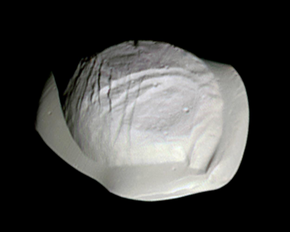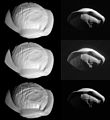Pan (moon)
 Color photo of Pan byCassiniin March 2017[a] | |
| Discovery | |
|---|---|
| Discovered by | M. R. Showalter |
| Discovery date | July 16, 1990 |
| Designations | |
Designation | Saturn XVIII |
| Pronunciation | /ˈpæn/ |
Named after | ΠάνPān |
| S/1981 S 13 | |
| Adjectives | Pandean/pænˈdiːən/[1] |
| Orbital characteristics[2] | |
| 133584.0±0.1 km | |
| Eccentricity | 0.0000144±0.0000054 |
| 0.575050718d(13.801217h) | |
| Inclination | 0.0001°±0.0004° |
| Satellite of | Saturn |
| Group | Shepherd moonof theEncke Gap |
| Physical characteristics | |
| Dimensions | 34.6 × 28.2 × 21.0km (±0.4 × 0.4 × 1.0km)[3]: 2 |
| 27.4±0.6 km[3]: 2 | |
| Volume | 10748km3[3]: 8 |
| Mass | (4.30±0.22)×1015kg[3]: 3 |
Meandensity | 0.400±0.031 g/cm3[3]: 3 |
| 0.0111–0.0169 m/s2[3]: 3 | |
| 0.006 km/s at longest axis to 0.007 km/s at poles | |
| synchronous | |
| zero | |
| Albedo | 0.5 |
| Temperature | ≈ 78 K |
Panis the innermost namedmoonofSaturn.[4]It is a small,ravioli[5]-shaped moon approximately 35kilometresacross and 23 km wide that orbits within theEncke Gapin Saturn'sA Ring.Pan is aring shepherdand is responsible for keeping the Encke Gap free of ring particles. It is sometimes described as having the appearance of awalnut.
It was discovered byMark R. Showalterin 1990 from analysis of oldVoyager 2probe photos and received the provisional designationS/1981 S 13because the discovery images dated back to 1981.[6]
Prediction and discovery[edit]
The existence of a moon in the Encke Gap was first predicted by Jeffrey N. Cuzzi and Jeffrey D. Scargle in 1985, based on wavy edges of the gap which indicated a gravitational disturbance.[7]In 1986, Showalteret al.inferred its orbit and mass by modeling its gravitational wake. They arrived at a precise prediction of 133,603 ± 10 km for the semi-major axis and a mass of 5–10×10−12Saturn masses, and inferred that there was only a single moon within the Encke gap.[8]The actual semi-major axis differs by 19 km, and the actual mass is 8.6×10−12of Saturn's.
The moon was later found within 1° of the predicted position. The search was undertaken by considering allVoyager 2images and using a computer calculation to predict whether the moon would be visible under sufficiently favorable conditions in each one. Every qualifying Voyager 2 image with a resolution better than ~50 km/pixel shows Pan clearly. In all, it appears in elevenVoyager 2images.[9][10]
Name[edit]
The moon was named on 16 September 1991[11]after the mythologicalGreekgod namedPan,who was (among other things) the god of shepherds. This is a reference to Pan's role as ashepherd moon.It is also designatedSaturn XVIII.[12]
Orbit[edit]
Theeccentricityof Pan's orbit causes its distance from Saturn to vary by ~4 km. Itsinclination,which would cause it to move up and down, is not distinguishable from zero with present data. TheEncke Gap,within which Pan orbits, is about 322 km wide.[13]
Geography[edit]

Cassiniscientists have described Pan as "walnut-shaped "[14]owing to theequatorial ridge,similar to that onAtlas,that is visible in images. The ridge is due to ring material that Pan has swept up from the Encke gap. It has been referred to by journalists as a spaceempanada,a form of stuffed bread or pastry, as well as aravioli.[15][16]A new study suggests that the bizarre shape of Pan could also be due to collisions between tinymoonlets,thus causing them to merge and form Pan (known as the pyramidal regime formation scenario).[17]
Pandean ringlet[edit]
The Encke Gap contains a ringlet that is coincident with Pan's orbit, indicating that Pan maintains the particles inhorseshoe orbits.[18]A second ringlet is periodically disrupted by Pan, similarly to how theF Ringis disturbed byPrometheus.[19]
Gallery[edit]
-
Closeup of the Encke Gap, showing the central ringlet that is coincident with Pan's orbit.
-
Cassiniimage showing Pan orbiting in the Encke Gap.
-
Equatorial view of Pan fromCassini,with the rings of Saturn surrounding the moon.
-
Pan in the center of the image, occupying the Encke Gap in Saturn's rings. Its walnut-like shape is clearly visible.
-
Stretched (4x) images, processed in various ways.
See also[edit]
Notes[edit]
- ^This color photo of Pan was created by combining separate photos taken in infrared, green, and ultraviolet spectral filters of theCassinispacecraft's narrow-angle Imaging Science Subsystem (ISS) camera on 7 March 2017. This view of the moon's northern hemisphere shows itswalnut-like appearance, with a highly inclined equatorial ridge almost eclipsing the moon's southern hemisphere from view.
References[edit]
- ^"Pandean".Oxford English Dictionary(Online ed.).Oxford University Press.(Subscription orparticipating institution membershiprequired.)
- ^Jacobson, R. A.; et al. (2008). "Revised orbits of Saturn's small inner satellites".Astronomical Journal.135(1): 261–263.Bibcode:2008AJ....135..261J.CiteSeerX10.1.1.653.3917.doi:10.1088/0004-6256/135/1/261.S2CID122998668.
- ^abcdefThomas, P. C.; Helfenstein, P. (July 2020). "The small inner satellites of Saturn: Shapes, structures and some implications".Icarus.344:20.Bibcode:2020Icar..34413355T.doi:10.1016/j.icarus.2019.06.016.S2CID197474587.113355.
- ^"Saturn - Moons".NASA.Archived fromthe originalon 7 September 2015.Retrieved5 October2017.
- ^"Saturn's Tiny Moon Pan Looks Like a Ravioli".CNET.Retrieved8 January2020.
- ^IAUC 5052:SaturnJuly 16, 1990 (discovery)
- ^Cuzzi, J. N.; and Scargle, J. D.;Wavy Edges Suggest Moonlet in Encke's Gap,Astrophysical Journal, Vol. 292 (May 1, 1985), pp. 276–290
- ^Showalter, M. R.; et al. (1986)."Satellite" wakes "and the orbit of the Encke Gap moonlet".Icarus.66(2): 297–323.Bibcode:1986Icar...66..297S.doi:10.1016/0019-1035(86)90160-0.
- ^Showalter, M. R. (1990)."Visual Detection of 1981 S 13, the Encke Gap Moonlet".Bulletin of the American Astronomical Society.22:1031.
- ^Showalter, M. R. (1991). "Visual detection of 1981 S 13, Saturn's eighteenth satellite, and its role in the Encke gap".Nature.351(6329): 709–713.Bibcode:1991Natur.351..709S.doi:10.1038/351709a0.S2CID4317496.
- ^IAUC 5347:Satellites of Saturn and Neptune1991 September 16 (naming the moon)
- ^"Planet and Satellite Names and Discoverers".Gazetteer of Planetary Nomenclature.USGS Astrogeology. 21 July 2006.Retrieved7 August2006.
- ^"Vital Statistics for Saturn's Rings and Inner Satellites".NASA Planetary Data System.
- ^"PIA08320: Cruising with Pan",Planetary Photojournal.
- ^Chang, Kenneth (10 March 2017)."Pan, Moon of Saturn, Looks Like a Cosmic Ravioli (or Maybe a Walnut)".The New York Times.Retrieved11 March2017.
- ^Perkins, Sid (9 March 2017)."Stunning close-up of Saturn's moon, Pan, reveals a space empanada".Science.
- ^"Here's Why Saturn's Inner Moons Are Shaped Like Ravioli and Potatoes".Space.22 May 2018.Retrieved8 February2021.
- ^Hedman, M.M.; Burns, J.A.; Hamilton, D.P.; Showalter, M.R. (2013). "Of horseshoes and heliotropes: Dynamics of dust in the Encke Gap".Icarus.223(1): 252–276.arXiv:1211.4762.Bibcode:2013Icar..223..252H.doi:10.1016/j.icarus.2012.11.036.S2CID974916.
- ^Porco, C.C.; Baker, E.; Barbara, John; Beurle, K.; Brahic, A.; Burns, J.A.; Charnoz, S.; Cooper, N.; Dawson, Douglas; Delgenio, Anthony; Denk, T.; Dones, Luke; Dyudina, Ulyana; Evans, M.W.; Giese, B.; Grazier, Kim; Helfenstein, Paul; Ingersoll, A.P.; Jacobson, R.A.; West, Robert (2005)."Cassini Imaging Science: Initial Results on Saturn's Rings and Small Satellites".Science.307(5713): 1226–1236.Bibcode:2005Sci...307.1226P.doi:10.1126/science.1108056.PMID15731439.S2CID1058405.





